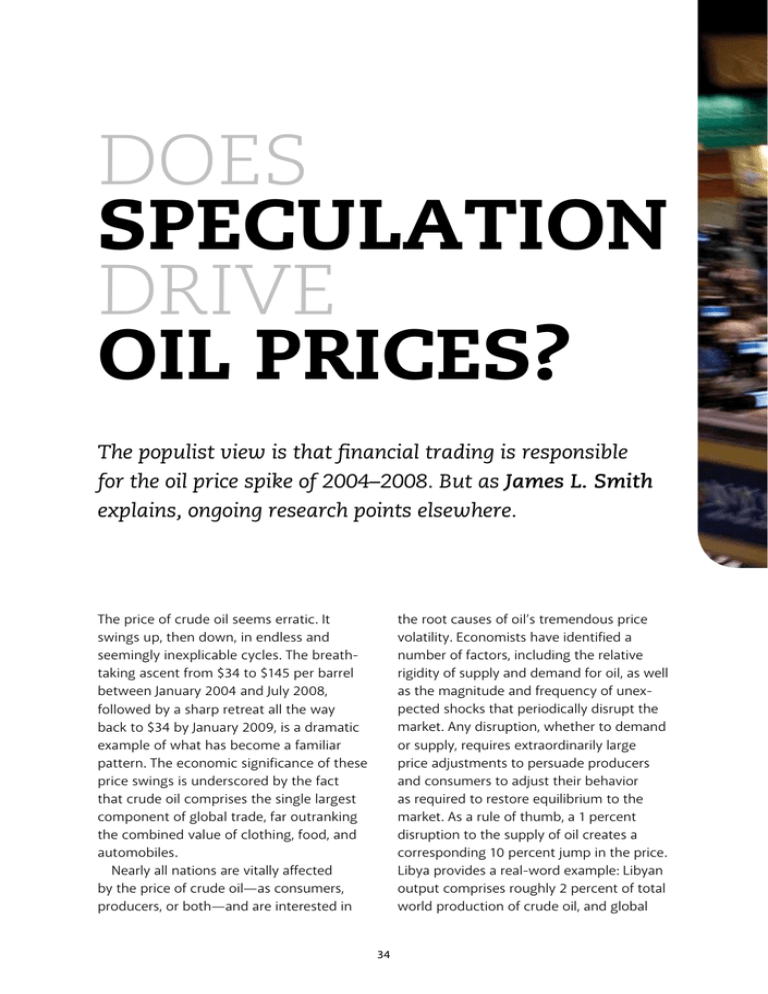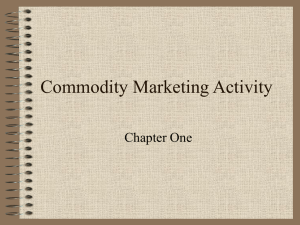Does DRive SPECULATION
advertisement

Does Speculation Drive Oil Prices? The populist view is that financial trading is responsible for the oil price spike of 2004–2008. But as James L. Smith explains, ongoing research points elsewhere. the root causes of oil’s tremendous price volatility. Economists have identified a number of factors, including the relative rigidity of supply and demand for oil, as well as the magnitude and frequency of unexpected shocks that periodically disrupt the market. Any disruption, whether to demand or supply, requires extraordinarily large price adjustments to persuade producers and consumers to adjust their behavior as required to restore equilibrium to the market. As a rule of thumb, a 1 percent disruption to the supply of oil creates a corresponding 10 percent jump in the price. Libya provides a real-word example: Libyan output comprises roughly 2 percent of total world production of crude oil, and global The price of crude oil seems erratic. It swings up, then down, in endless and seemingly inexplicable cycles. The breathtaking ascent from $34 to $145 per barrel between January 2004 and July 2008, followed by a sharp retreat all the way back to $34 by January 2009, is a dramatic example of what has become a familiar pattern. The economic significance of these price swings is underscored by the fact that crude oil comprises the single largest component of global trade, far outranking the combined value of clothing, food, and automobiles. Nearly all nations are vitally affected by the price of crude oil—as consumers, producers, or both—and are interested in 34 © Ramin Talaie/Corbis tupled between 2004 and 2008. Although the number of contracts held by commercial traders—producers and consumers of oil who use futures contracts to hedge their natural exposure to price risk—also grew, the increase was less and their market share declined from 67 percent to 50 percent between those years. Since the financial influx was accompanied by a steep ascent in oil prices, it is natural to ask whether this represents coincidence or causality. prices jumped roughly 20 percent when Libyan shipments were blocked by revolution last year. Alongside these fundamental reasons for the volatility of oil prices, there are persistent concerns that excessive speculation and financial trading in the futures market have played a role. These concerns emerged as the flow of “managed money”—financial investments placed by hedge funds, pension plans, commodity index funds, and the like—into the commodity markets escalated in recent years. This so-called “financialization” of the futures markets (crude oil included) has been well documented. For example, the total number of crude oil futures contracts held by hedge funds quin- Common Wisdom and Its Shortcomings The populist view is quite simple: whenever a large influx of new money comes into a market, it forces up the price of the product, 35 expires. This is the mechanism by which futures traders take their gains and losses, known in the industry as “financial settlement.” No hedge fund wants to receive a cargo of crude oil delivered to its door, but this can only be avoided if the hedge fund sells back all of its contracts before they and when that money leaves, the price must fall. As a general economic proposition, this view occupies hallowed ground, capturing the spirit of Milton Friedman’s quantity theory of money, which sees inflation as the end result when a growing supply of money chases a fixed supply An influx of money into the futures market does not, per se, move the price of oil. Only a change in expectations regarding market conditions can do that. expire. Every futures contract purchased by an investor is subsequently sold back by that same investor, and this fact is known and anticipated by all investors in the market. Thus, for each and every contract, buying pressure equals selling pressure—which ultimately equals no pressure. Futures trades neither add nor remove oil from the physical supply chain, where the spot price of oil is determined. Thus, an influx of money into the futures market does not, per se, move the price of oil. Only a change in expectations regarding market conditions can do that. This leads us to consider the alternative hypothesis of contagion, a channel by which financial traders may conceivably impact the price. If heightened trading by financial investors alters the expectations of commercial traders, then any resulting adjustments to production, inventories, or consumption could move prices to a new level. Was this behind the recent price spikes? of goods. Applications of this principle to certain individual commodities may be appropriate. For example, recent recordbreaking prices of the best vintages of fine Bordeaux wine can safely be attributed to the new and large influx of Chinese demand chasing what is an absolutely fixed supply of the product. But attempts to extend the logic of the quantity theory to the operation of futures markets fail badly. The first failing arises because the quantity of futures contracts, unlike the supply of Bordeaux, is not fixed, but expands or contracts to equilibrate the market. When a hedge fund manager expresses a desire to purchase oil futures at $100 per barrel, his demand can be supplied simply by creating a contract de novo and selling it to him. And if he wants another, it can be created and sold as well. The seller would only do so, of course, if he expected oil to sell in the future for less than $100 per barrel, but regardless of prevailing price expectations, futures contracts always can be created to accommodate demand. (If only that were true of fine Bordeaux.) The second failing is to assume that an influx of money necessarily creates buying pressure. In fact, each contract initially purchased by an investor will be resold by that same investor before the contract What Research Tells Us Economists tend to believe that prices reflect expectations, and when expectations change, prices follow. It is an empirical question whether the actions of financial traders had such an impact on expectations and prices during the 2008 oil price spike. 36 Fortunately, empirical research has begun to provide some answers. Most relevant to the question of placing new restrictions on futures trading are studies that focus directly on the impact of trades made by hedge funds and other of contracts by hedge funds indeed causes prices to rise, then such a pattern should be apparent in the historical data. But researchers have found that in fact, the opposite pattern emerges. From 2000 to 2009, hedge funds and other financial traders seem to © Neville Elder/Corbis From 2000 to 2009, hedge funds and other financial traders seem to have adjusted positions in response to price movements; their trades do not appear to have caused price movements. financial investors. Using comprehensive data from the Commodity Futures Trading Commission (CFTC) that reflect individual trading patterns in the NYMEX WTI crude oil futures contract, these studies investigate whether price movements typically have been preceded by changes in the trading positions of hedge funds and other types of financial investors. If the accumulation have adjusted positions in response to price movements; their trades do not appear to have caused price movements. The behavior of other commodities not widely traded on futures markets provides corroborating evidence and suggests that the 2008 oil price spike was probably due to the unprecedented increase in demand for all industrial commodities that 37 metric models) to model misspecification, left-out variables, and unaccounted shocks that have nothing to do with speculative trading. At best, this simple “not elsewhere classified” approach to price movements suggests that speculation could account, at most, for 25 percent of observed oil price variations. The question has been subjected to more rigorous analysis in the form of structural vector autoregressive (SVAR) models. Roughly speaking, this approach attempts to isolate and distinguish the several causes of observed price movements and measure their relative importance. It is based on the hypothesis that different types of shocks leave distinctive fingerprints on the price of oil. For example, demand shocks associated with unexpected changes in the global business cycle should cause global oil produc- © David Brabyn/Corbis emanated from India and China, rather than the financialization of the futures market. Studies by the International Energy Agency and other researchers show that prices of non-traded commodities like manganese, rice, cobalt, and coal all tended to rise and fall in unison with oil between 2004 and 2009, without any prompting or prodding by futures traders. Other strands of current research bear on the question at hand, albeit from somewhat different perspectives. For example, simple attempts to model and measure fluctuations in the basic fundamental determinants of oil prices leave about 25 percent of total price movements unexplained. One interpretation is that the residual percentage might be due to speculation. Another is that the unexplained portion of observed price movements is due (as in many econo- 38 Regulatory Response tion, global economic activity, and the price of oil all to increase, whereas supply shocks should cause the price of oil to increase while global oil production and economic activity both fall. Shocks to the speculative demand for oil should cause inventories to accumulate at the same time that oil prices rise. By searching through all these related time series for the characteristic Despite ongoing research, the question of whether oil speculation caused the recent spike in oil prices appears settled to some observers. New regulatory policies are taking shape in the United States and elsewhere based on the assumption that financial speculation and excessive futures trading push oil prices away from funda- Any summary of the peer-reviewed research produced so far would place the weight of evidence on the side that market fundamentals, not financial speculation, drive the price of oil. fingerprints, the SVAR technique apportions observed variation in oil prices to its various components. The most straightforward application of the SVAR technique finds historical evidence that speculation moved oil prices on numerous occasions—in 1979, 1986, 1990, and late 2002—which accords with other anecdotal evidence. It provides little support, though, for the notion that the oil price surge between 2004 and 2008 was due to speculation. Rather, the analysis identifies a series of negative supply shocks and, more significantly, a series of positive demand shocks as causes of the price spike. Empirical research on the impact of financial trading is subject to many limitations, and while research remains ongoing, it seems prudent to keep an open mind. Yet any summary of the peer-reviewed research produced so far would place the weight of evidence on the side that market fundamentals, not financial speculation, drive the price of oil. mental values. As part of the Dodd-Frank financial overhaul, for example, the Federal Reserve, Securities and Exchange Commission, and CFTC are circulating reforms that will impose new costs on financial investors and limit their investment in futures contracts. Whether these policies will have the intended effect remains to be seen— the channel by which financial trading might impact commodity prices is anything but transparent. Further Reading Buyuksahin, Bahattin, and Jeffry H. Harris. 2011. Do Speculators Drive Crude Oil Futures Prices? The Energy Journal 32(2): 167–202. Fattouh, Bassam, Lutz Kilian, and Lavan Mahadeva. 2012. The Role of Speculation in Oil Markets: What Have We Learned so Far? Working paper. http://www-personal.umich. edu/~lkilian/milan030612.pdf. Irwin, Scott H., and Dwight R. Sanders. 2012. Testing the Masters Hypothesis in Commodity Futures Markets. Energy Economics 34: 256–69. Smith, James L. 2009. World Oil: Market or Mayhem? Journal of Economic Perspectives 23(3): 145–164. Stoll, Hans R., and Robert E. Whaley. 2010. Commodity Index Investing and Commodity Futures Prices. Journal of Applied Finance 20(1): 7–46. 39




